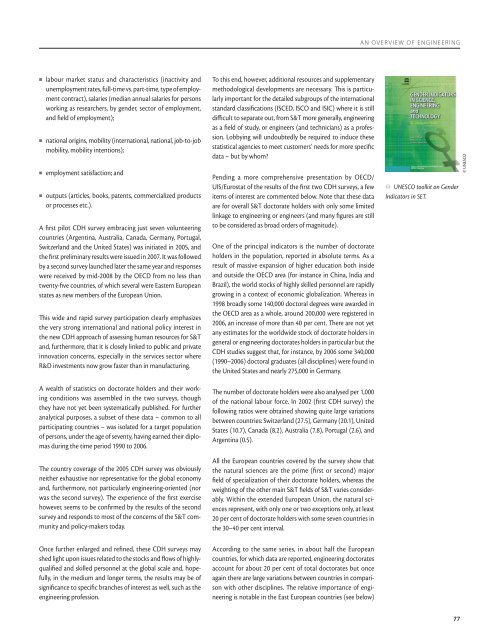Engineering: issues, challenges and opportunities for development ...
Engineering: issues, challenges and opportunities for development ...
Engineering: issues, challenges and opportunities for development ...
Create successful ePaper yourself
Turn your PDF publications into a flip-book with our unique Google optimized e-Paper software.
AN OVERVIEW OF ENGINEERING■■■■labour market status <strong>and</strong> characteristics (inactivity <strong>and</strong>unemployment rates, full-time vs. part-time, type of employmentcontract), salaries (median annual salaries <strong>for</strong> personsworking as researchers, by gender, sector of employment,<strong>and</strong> field of employment);national origins, mobility (international, national, job-to-jobmobility, mobility intentions);employment satisfaction; <strong>and</strong>outputs (articles, books, patents, commercialized productsor processes etc.).A first pilot CDH survey embracing just seven volunteeringcountries (Argentina, Australia, Canada, Germany, Portugal,Switzerl<strong>and</strong> <strong>and</strong> the United States) was initiated in 2005, <strong>and</strong>the first preliminary results were issued in 2007. It was followedby a second survey launched later the same year <strong>and</strong> responseswere received by mid-2008 by the OECD from no less thantwenty-five countries, of which several were Eastern Europeanstates as new members of the European Union.This wide <strong>and</strong> rapid survey participation clearly emphasizesthe very strong international <strong>and</strong> national policy interest inthe new CDH approach of assessing human resources <strong>for</strong> S&T<strong>and</strong>, furthermore, that it is closely linked to public <strong>and</strong> privateinnovation concerns, especially in the services sector whereR&D investments now grow faster than in manufacturing.To this end, however, additional resources <strong>and</strong> supplementarymethodological <strong>development</strong>s are necessary. This is particularlyimportant <strong>for</strong> the detailed subgroups of the internationalst<strong>and</strong>ard classifications (ISCED, ISCO <strong>and</strong> ISIC) where it is stilldifficult to separate out, from S&T more generally, engineeringas a field of study, or engineers (<strong>and</strong> technicians) as a profession.Lobbying will undoubtedly be required to induce thesestatistical agencies to meet customers’ needs <strong>for</strong> more specificdata – but by whom?Pending a more comprehensive presentation by OECD /UIS/ Eurostat of the results of the first two CDH surveys, a fewitems of interest are commented below. Note that these dataare <strong>for</strong> overall S&T doctorate holders with only some limitedlinkage to engineering or engineers (<strong>and</strong> many figures are stillto be considered as broad orders of magnitude).One of the principal indicators is the number of doctorateholders in the population, reported in absolute terms. As aresult of massive expansion of higher education both inside<strong>and</strong> outside the OECD area (<strong>for</strong> instance in China, India <strong>and</strong>Brazil), the world stocks of highly skilled personnel are rapidlygrowing in a context of economic globalization. Whereas in1998 broadly some 140,000 doctoral degrees were awarded inthe OECD area as a whole, around 200,000 were registered in2006, an increase of more than 40 per cent. There are not yetany estimates <strong>for</strong> the worldwide stock of doctorate holders ingeneral or engineering doctorates holders in particular but theCDH studies suggest that, <strong>for</strong> instance, by 2006 some 340,000(1990–2006) doctoral graduates (all disciplines) were found inthe United States <strong>and</strong> nearly 275,000 in Germany. UNESCO toolkit on GenderIndicators in SET.© UNESCOA wealth of statistics on doctorate holders <strong>and</strong> their workingconditions was assembled in the two surveys, thoughthey have not yet been systematically published. For furtheranalytical purposes, a subset of these data – common to allparticipating countries – was isolated <strong>for</strong> a target populationof persons, under the age of seventy, having earned their diplomasduring the time period 1990 to 2006.The number of doctorate holders were also analysed per 1,000of the national labour <strong>for</strong>ce. In 2002 (first CDH survey) thefollowing ratios were obtained showing quite large variationsbetween countries: Switzerl<strong>and</strong> (27.5), Germany (20.1), UnitedStates (10.7), Canada (8.2), Australia (7.8), Portugal (2.6), <strong>and</strong>Argentina (0.5).The country coverage of the 2005 CDH survey was obviouslyneither exhaustive nor representative <strong>for</strong> the global economy<strong>and</strong>, furthermore, not particularly engineering-oriented (norwas the second survey). The experience of the first exercisehowever, seems to be confirmed by the results of the secondsurvey <strong>and</strong> responds to most of the concerns of the S&T community<strong>and</strong> policy-makers today.All the European countries covered by the survey show thatthe natural sciences are the prime (first or second) majorfield of specialization of their doctorate holders, whereas theweighting of the other main S&T fields of S&T varies considerably.Within the extended European Union, the natural sciencesrepresent, with only one or two exceptions only, at least20 per cent of doctorate holders with some seven countries inthe 30–40 per cent interval.Once further enlarged <strong>and</strong> refined, these CDH surveys mayshed light upon <strong>issues</strong> related to the stocks <strong>and</strong> flows of highlyqualified<strong>and</strong> skilled personnel at the global scale <strong>and</strong>, hopefully,in the medium <strong>and</strong> longer terms, the results may be ofsignificance to specific branches of interest as well, such as theengineering profession.According to the same series, in about half the Europeancountries, <strong>for</strong> which data are reported, engineering doctoratesaccount <strong>for</strong> about 20 per cent of total doctorates but onceagain there are large variations between countries in comparisonwith other disciplines. The relative importance of engineeringis notable in the East European countries (see below)77

















